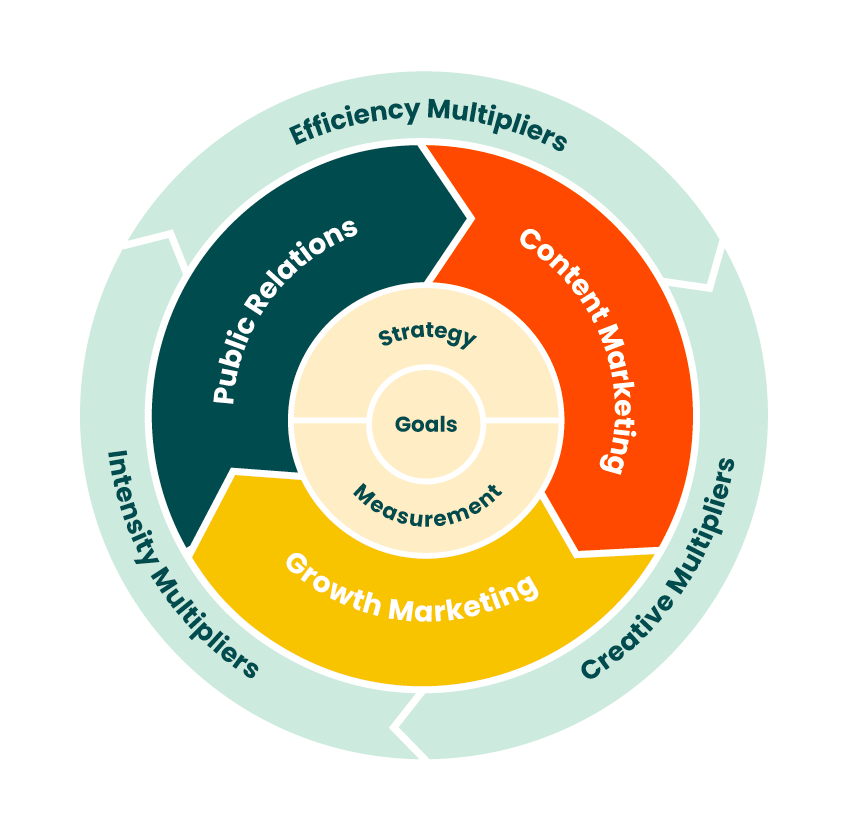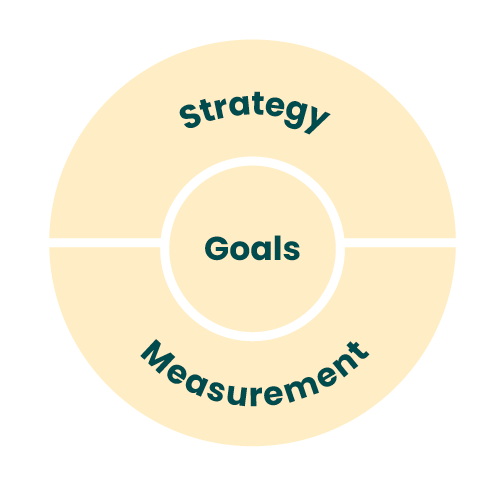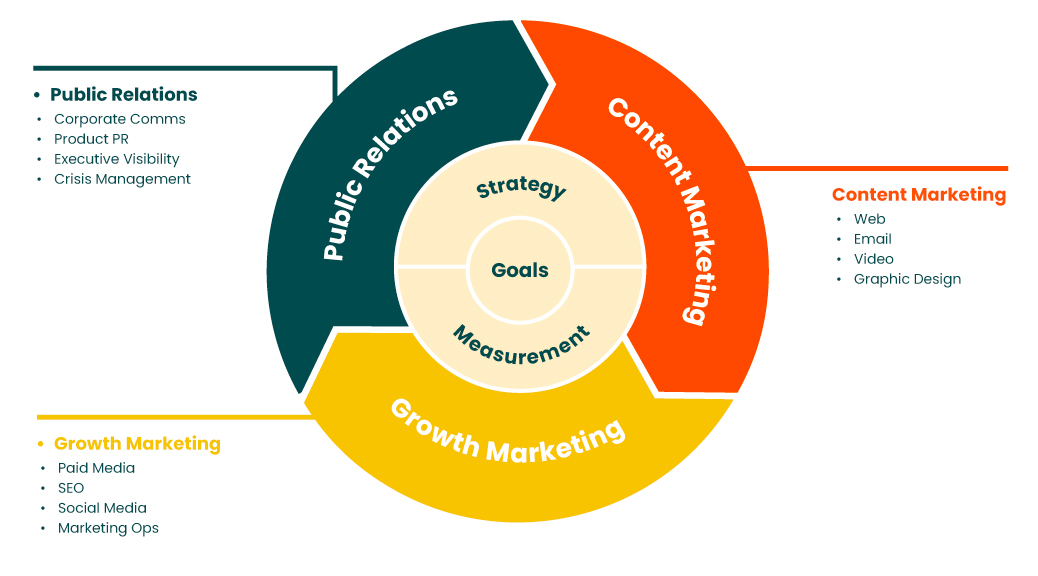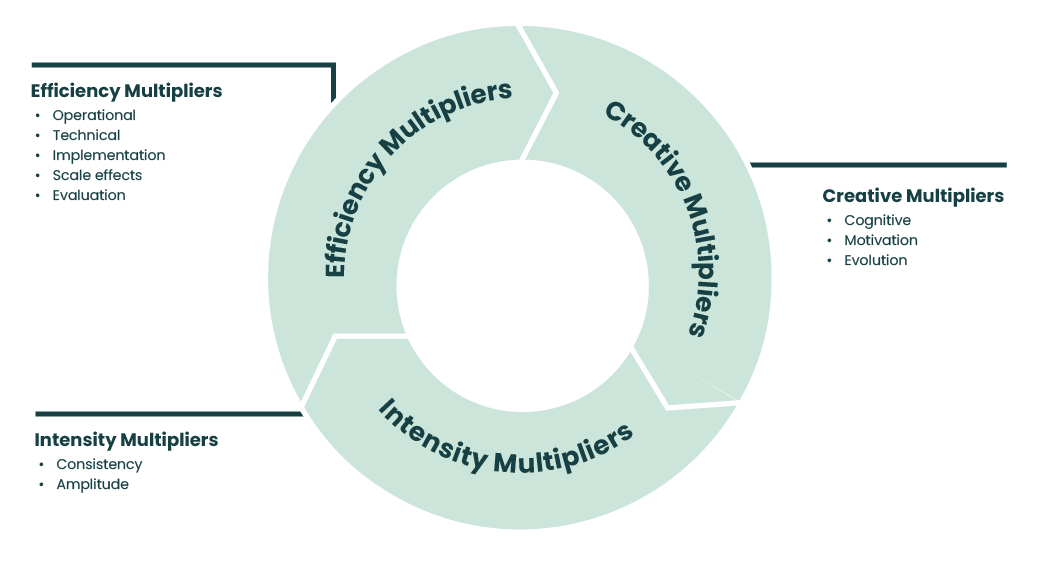Multiplier Marketing
Unlike traditional siloed programs, Multiplier Marketing harmonizes public relations, content marketing and growth marketing efforts to spike awareness and move buyers down the funnel even faster.

Multiplier Marketing unlocks intensity, creativity, and efficiency multipliers to spark stronger ideas that are better executed in sync across channels — and gives startups the boost they need to outperform their competitors.

The Core of Multiplier Marketing
From there we develop the overall strategy, which can be multidisciplinary across PR, content marketing and growth marketing. We also develop the measurement approach. This can compare performance over time, against competitors and industry benchmarks. Central to our measurement is attribution data, which often involves configuring the martech stack so it can capture everything we need.
The Firebrand Flywheel
Each practice spans a range of services. For instance, growth marketing includes paid media, SEO, social media, and marketing operations.
Each practice’s activities reinforce, inform, or amplify the tactics of the others. This starts a flywheel effect with the outputs in one area acting as the inputs for the next — all of which leads to better performance.

THE THREE MARKETING MULTIPLIERS
Multiplier Marketing unlocks intensity, creativity, and efficiency multipliers to spark stronger ideas
that are better executed in sync across channels.
Efficiency Multipliers
Intensity Multipliers
Creativity Multipliers
A traditional approach to marketing overlooks these multiplier gains. Efficiency drivers alone provide strong yields from integrated multiplier marketing. Creative and intensity multipliers can create a breakout impact for startups without increasing overall spend.

Efficiency Multipliers
For example, lowering the coordination overhead on a long series of activities is clearly more efficient. Non-integrated teams often have conflicting priorities that hold up campaigns and can have resourcing constraints or misunderstandings about the concept causing poor implementation.
With a fully integrated team, feedback is seamlessly shared across practices — meaning everyone will know about changes in buyer behavior and the messages that impact them sooner. Being able to quickly share what’s working and what isn’t makes the organization more agile and responsive.
Efficiency multipliers include:
- Operational – how the work is done
-
- Fewer meetings – reducing the number of interactions to complete a process
- Fewer questions – reducing the number of clarifications required, less friction
- Eliminating delays – removing pauses caused by blocked dependencies and approvals
- Technical – where the work is done
- Shared systems – streamlining task management, document access and content creation
- Implementation – what work is done
- Longer process flows – increasing the number of tasks in a flow of activity that is triggered by a single idea or event
- Best practices – a shared understanding, vocabulary and approach reduces rework and confusion
- Scale effects – getting there more effectively
- Running programs together accesses purchasing economies with media vendors and other vendors
- Greater reuse of marketing materials including creative, designs and collateral
- Pooling resources from across the marketing budget opens up new opportunities that a segmented budget would not be able to consider
- Agility – quickly learning and adapting
- Changes in buyer behavior are communicated quickly
- Tactics that over- or under-perform are quickly shared
- Changes within the organization (to resources, offerings, budgets) can be reflected swiftly in the marketing program
- Evaluation – how the work is assessed
- Measurement – unitary method to set goals and measure success
Intensity Multipliers
Intensity multipliers include:
- Consistency – achieve frequency and duration
- If the messaging across different programs is the same, the buyer will be exposed to it at a higher frequency
- If different programs run the same messaging at different times, the buyer will be exposed to it over a longer duration
- Consistent programs reflect more positively on the brand over time than disparate ones
- Amplitude – turn up the volume
- Programs running in concert are more likely to break through into awareness and consideration with the buyer
- The modern sales funnel – known as the dark funnel – is longer, more convoluted, and involves many more stakeholders. Being present in multiple channels increases a brand’s ability to reach buyers and influencers no matter the stage they’re at
Creative Multipliers
At an individual level, the act of creativity is delicate and requires a high level of trust. Creating psychological safety for ideas to blossom is challenging if team members are unfamiliar with each other or have different motivations. A multidisciplinary team with a variety of thinking styles will spark orthogonal ideas with more frequency than a siloed team. These may feel like soft factors, but anyone who has brainstormed creative concepts will know how fragile ideas are when they are generated and how important it is to create a volume of strong ideas to choose from. That all stems from having a room of people who trust each other and bring unique perspectives.
Creative multipliers include:
- Cognitive – how people think
- Thinking style – people who think in different ways such as visual, acoustic, or in words will generate ideas that others don’t. You find those people in different practices
- Practice diversity – ideas are often earthed in what is possible. People from paid, organic, earned and social media backgrounds will come at a problem through that lens
- Motivations – of those involved
- Eliminating competitive tensions creates alignment and prevents ideas from being held back
- Encouraging a cross-disciplinary approach works toward shared outcomes
- Trust – generating great ideas only happens in a trusting environment, which is harder to create among multiple organizations
- Evolutionary – sparking divergent ideas
- Exposure to other elements of the campaign increases the chances of new divergent ideas being sparked
Examples of Marketing Multipliers in Action
Here are some ways that these Marketing Multipliers yield stronger outcomes. We’ve broken them out into combinations of different practices but they are often not as siloed as these.
PR + Content Marketing
- Tighter coordination around major announcements like product launches and funding
- Maximum exposure of editorial coverage across social, email, web
- Repurposing primary research across demand gen and media relations
- Stronger synchronization of content and editorial calendars around themes and topics
PR + Paid Media
- Reinforcing editorial media placements with paid sponsorships
- Strengthening relevance of paid media messaging
- Offsetting hard-to-reach titles with paid media
- Quickly pausing or evolving paid programs during a crisis to avoid compounding it
PR + SEO
- Informing topics for editorial pitching and messaging with keyword research
- Generating high authority backlinks with media coverage
- Creating inbound links and referral traffic from influencer programs
Content Marketing + Paid Media
- Driving paid traffic to blog posts, bylines, lead generation magnets, videos and case studies
- Quickly launching paid programs for landing pages and gated content
- Automatically creating drip email flows to nurture paid leads
Content Marketing + SEO
- Easily researching critical keywords to inform content that resonates
- Surging intent data from ABM helps to pivot the content calendar
- Fresh content is rapidly search optimized
- Ensuring website changes are sensitive to the keyword profile
